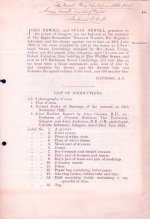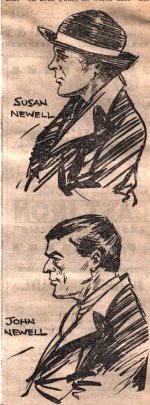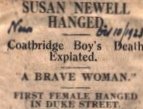Case against John Newell and Susan Newell (1923), Glasgow
John Newell and Susan Newell were accused of the murder by throttling of a thirteen year old boy, John Johnstone in Coatbridge, Glasgow, 1923. The case was known as the 'Go-Cart Tragedy' or the 'Coatbridge Murder'. Professor John Glaister, Senior was a witness in the case against the Newell's who were tried at the Criminal Court House in Glasgow, September 1923. Mr Newell was acquitted as he had an alibi. Mrs Newell was found guilty of murder and sentenced to death by hanging. She was executed in Glasgow's Duke Street Prison in October 1923.
22nd June 1923
Police arrest a woman (28) who was alleged to have conveyed a body to the Duke Street close in a go-cart, along a busy high way for about eight miles, covered in a quilt and propped up, and attempted to escape by scaling a wall. Mrs Newell was arrested and taken to police station at Tobago Street. Police were searching for a man. John Newell eventually surrendered himself to the police at Haddington.
The first photographs began to appear in the press, they include an image of the tenement where the body of John Johnstone was deposited.
 |
23rd June A Man and Wife in Custody. Professor John Glaister and Dr John Anderson of the Victoria Infirmary carried out a post-mortem examination on the body of the 'dead lad' at Glasgow's Central Police Mortuary, yesterday. 25th June A witness came forward to say he had given Mrs Newell and the the go-cart a lift. 10th September: The accused were brought before the Sheriff at Glasgow. The indictment (Ref. GUA FM/2B/9/1) includes a list of 19 productions, which included photographs and plans of the locus, medical reports, a go-cart, 2 bed covers and a poker, and the names of 17 witnesses. |
 |
Ref: GUA FM/2B/9 18th September Opening of Go-Cart Murder Trial in Glasgow To-Day . Mrs Newell's Daughter in the Witness-Box . The accused's daughter says she sat on the boy's dead body (bundle) when travelling in a lorry to Glasgow. Both John and Susan Newell pleaded not guilty, the husband had a special defence of alibi. Mrs Newell wore a blue costume and a black straw hat with a white band. Newell was attired in a working suit, and wore a grey-coloured muffler, and carried his cap in his hand. |
 |
19th September Trial Closing The Newell's were photographed in the dock. After hearing John Newell's evidence in support of his plea of an alibi, the Crown withdrew the charge against him, and he was discharged. The Jury were locked up in Glasgow's Central Station. Questions were asked regarding the wife's sanity, but doctors find no evidence of mental instability. According to the Jury, the crime was committed in a 'moment of frenzy', as Mrs Newell had been left by her husband without money and she was about to be turned from her home into the street, and took it out on the boy. |
 |
Ref: GUA FM/2B/9 20th September Mrs Newell was found guilty and sentenced to death. She was to be 'hanged by the neck until she was dead'. 10th October The execution was carried out in the Duke Street Prison on the morning of 10 th October 1923. Efforts made for a reprieve failed. Mrs Newell was the 'First Female Hanged in Duke Street'. |
Associated material
- National Records of Scotland: Reference AD15/23/71, Precognitions against John and Susan Newell, Trial Papers, JC26/1923/12, Plan of House, RHP140163.
Publications
- See Glaister, J. (1964) Final Diagnosis (London: Hutchinson)

